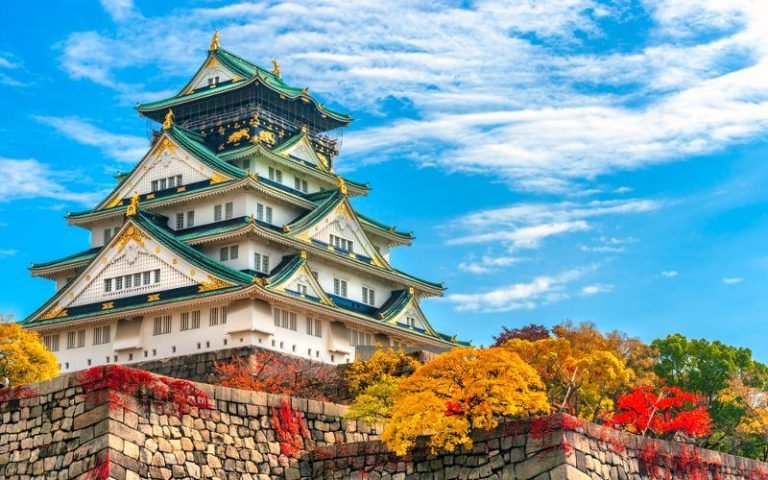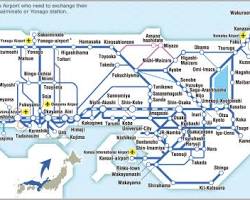Osaka Travel Guide
Home » Asia Pacific » Japan » Osaka » Osaka Travel Guide
Osaka, is the second-largest metropolitan area in Japan, after Tokyo. It is known for its lively and energetic atmosphere, its delicious food (including street food like takoyaki and okonomiyaki), and its many historical and cultural attractions. Osaka is also home to a number of amusement parks and nightlife districts, making it a popular destination for both tourists and locals.

Attractions
Popular Attractions
Weather
Osaka Weather by Month
Here’s a table showing the average monthly temperature (°C) and rainfall (mm) in Osaka:
| Month | Temperature (°C) | Rainfall (mm) |
|---|---|---|
| January | 4.9 | 46.2 |
| February | 6.0 | 50.9 |
| March | 9.3 | 62.2 |
| April | 14.0 | 84.3 |
| May | 18.6 | 129.3 |
| June | 21.5 | 189.2 |
| July | 25.2 | 210.4 |
| August | 27.9 | 151.5 |
| September | 25.6 | 175.1 |
| October | 19.7 | 120.7 |
| November | 13.2 | 60.3 |
| December | 8.2 | 52.5 |
Osaka Travel Guide: Best Time to Travel
Spring (March to May):
- Pros: Pleasant weather with mild temperatures, beautiful cherry blossoms (late March to early April), fewer crowds compared to summer.
- Cons: Can be rainy, especially in April and May. Prices might be slightly higher due to peak season around cherry blossoms.
Summer (June to August):
- Pros: Warmest weather, lively festivals and events (including the famous Tenjin Matsuri in July), longer daylight hours.
- Cons: Very hot and humid, highest rainfall, largest crowds, most expensive hotel rates.
Autumn (September to November):
- Pros: Comfortable temperatures, vibrant fall foliage (mid-November to early December), quieter and less crowded than spring and summer.
- Cons: Can be typhoon season (late July to October), some rainy days possible.
Winter (December to February):
- Pros: Lowest prices and least crowded, pleasant winter illuminations, unique winter festivals.
- Cons: Coldest weather, occasional snowfall (not as common as other parts of Japan), some attractions may have shorter hours.
Considerations:
- Personal preferences: If you prefer warm weather and don’t mind crowds, summer might be okay. If you prefer cooler weather and avoid peak season, spring or autumn might be better.
- Festivals and events: Check if there are any specific festivals or events you’d like to attend and choose your travel dates accordingly.
- Prices: Hotel rates and flight prices fluctuate depending on the season. Keep that in mind when making your decision.
Public Transportation
Public Transportation
Navigating Osaka with Ease: A Public Transport Paradise
Osaka boasts a comprehensive and user-friendly public transport system, making it a breeze to explore the city’s vibrant districts and hidden gems. Whether you’re a seasoned traveler or a first-time visitor, getting around Osaka is a stress-free experience.
Multiple Modes, Seamless Connections:
- Subways: The extensive subway network covers almost every corner of the city, ensuring efficient and fast connections. Lines are clearly marked with colors and English translations, making navigation intuitive. Opens in a new windowosakametro.co.jp
- Trains: JR lines connect Osaka to neighboring cities and major attractions like Universal Studios Japan. Opens in a new windowwww.jrailpass.com
- Buses: While less comprehensive than subways, buses offer a more scenic way to explore and reach outlying areas. Opens in a new windowosaka-info.jp
- Trams: Offering a nostalgic charm, trams operate in specific areas like Abeno and provide a unique view of the city. Opens in a new windowwww.urbanrail.net
Convenience at Your Fingertips:
- Osaka Metro Pass: Ideal for unlimited rides on subways and buses for 1, 2, or 3 days. Perfect for exploring different neighborhoods. Opens in a new windowsubway.osakametro.co.jp

- JR West Rail Pass: Covers JR lines within the Kansai region, including Osaka, Kyoto, and Nara, ideal for multi-city trips.

ICOCA & Suica Prepaid Cards: These rechargeable cards offer contactless convenience for subway, bus, and train fares. Widely accepted throughout Japan.


Tips for the Savvy Traveler:
- Download offline maps and navigation apps for additional guidance.
- Consider purchasing a multi-day pass based on your itinerary and travel plan.
- Opt for ICOCA or Suica cards for easier fare payments and quick transfers.
- Learn basic Japanese phrases like “Doko e ikimasu ka?” (Where are you going?) for assistance.
Osaka, is the second-largest metropolitan area in Japan, after Tokyo. It is known for its lively and energetic atmosphere, its delicious food (including street…










